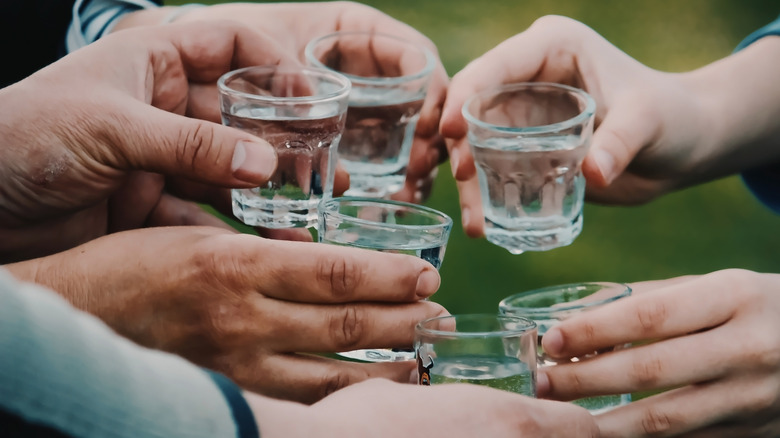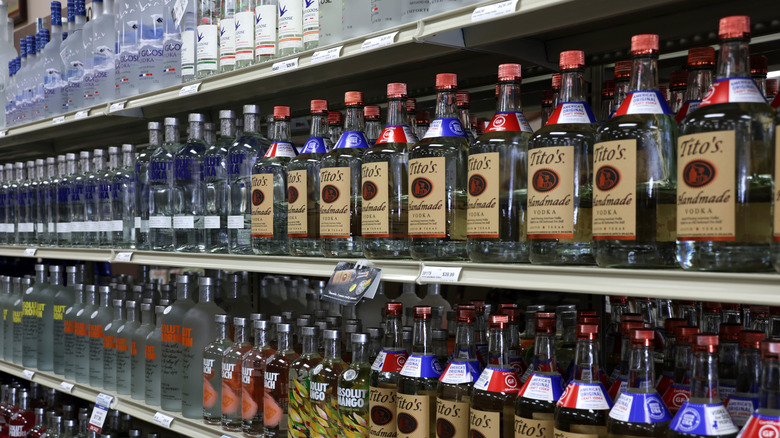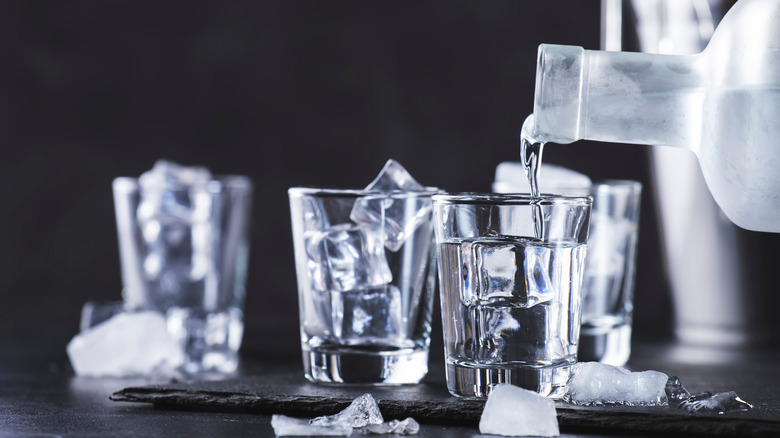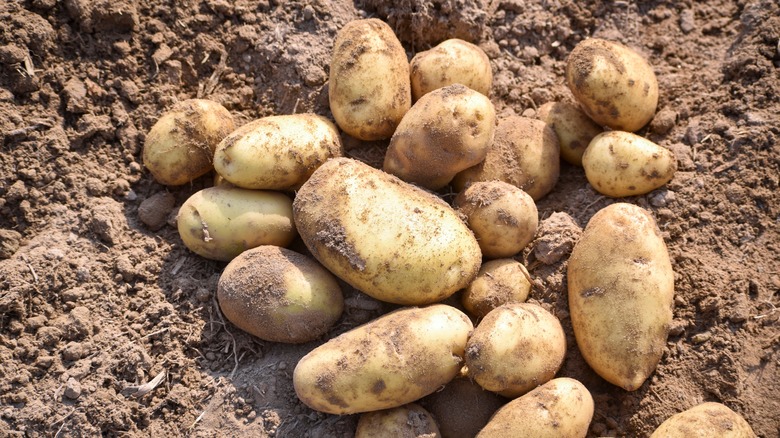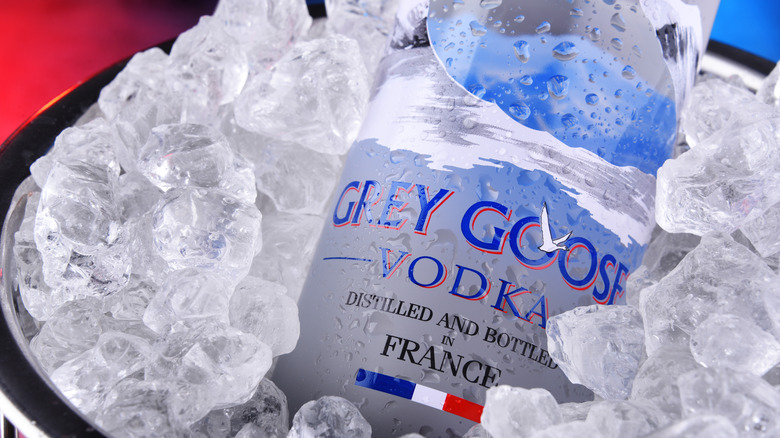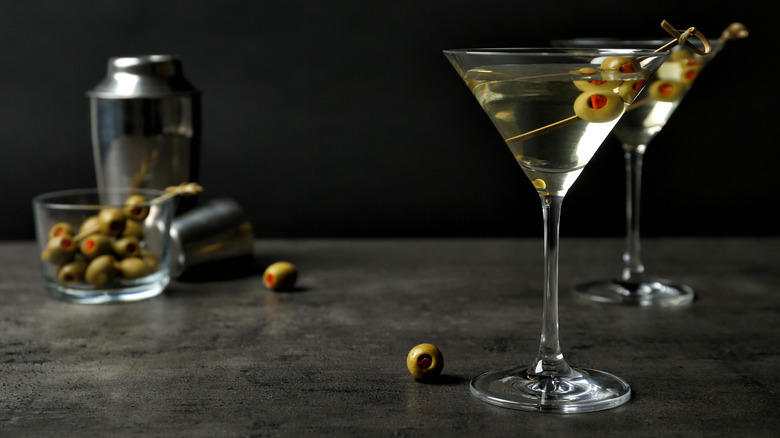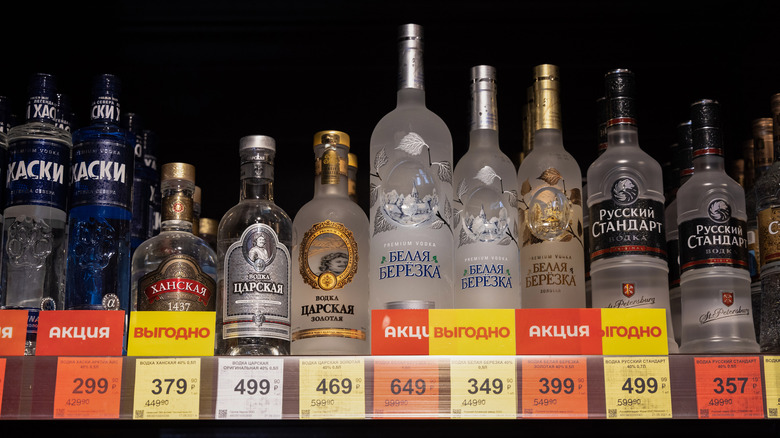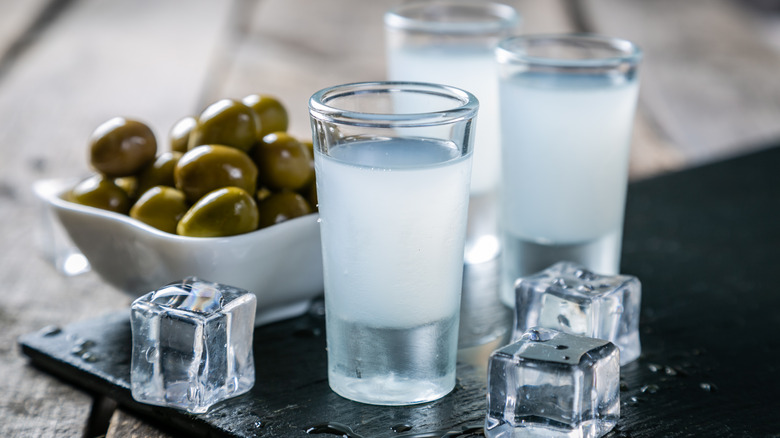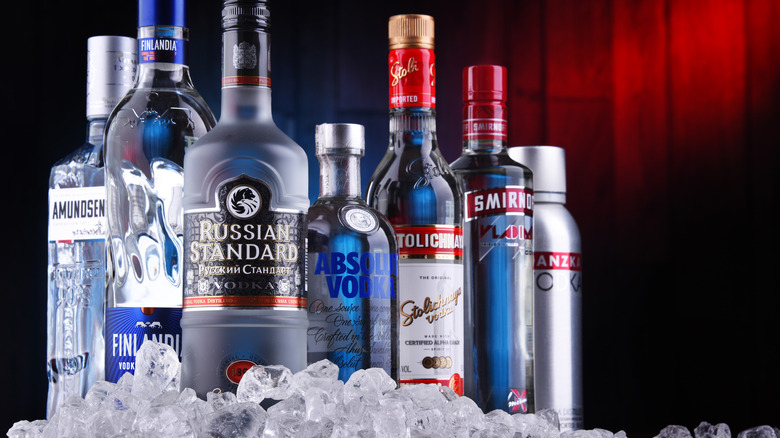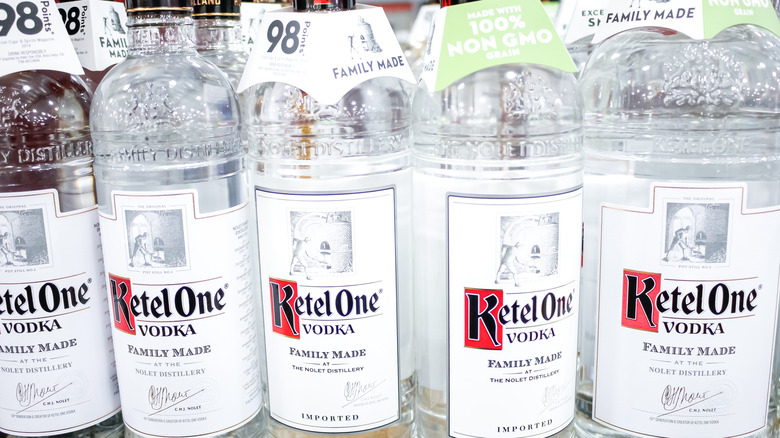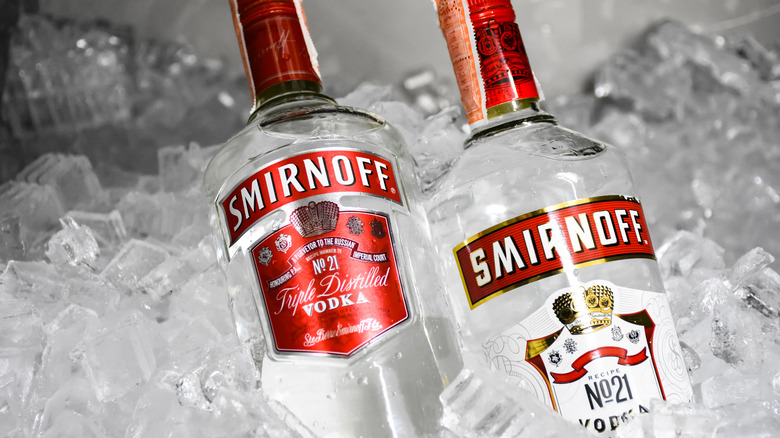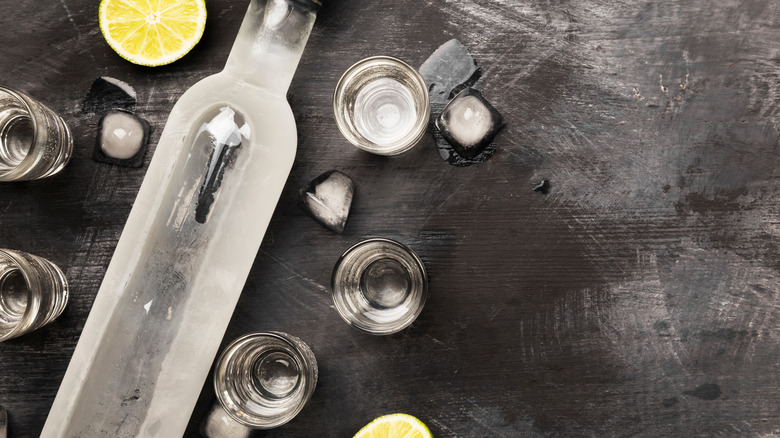Vodka Myths You Should Stop Believing
We may receive a commission on purchases made from links.
If you drink the occasional vodka soda or Moscow mule while out at the bar, then you might think that most vodkas are the same. After all, isn't vodka the one spirit that's completely odorless, tasteless, and colorless? Shouldn't that mean that every bottle is literally exactly alike?
Well, not quite. There are actually many misconceptions surrounding vodka, from the idea that different brands really are all the same to the notion that most vodka comes from Russia, the country that also drinks the most vodka in the world (in actuality, all of these things are wrong). Turns out, this clear spirit — one that spends most of its time lurking at the bottom of flavorful cocktails in order to mask its astringent flavor — is probably a lot more interesting than you think.
Keep reading for the vodka myths you should stop believing, along with the truth behind the lies. You'll thank us when you're regaling your friends at the bar this weekend with your newfound knowledge on all things vodka.
All vodka tastes the same
Anyone who's not a frequent vodka drinker will likely tell you that all vodka tastes the same. However, this sentiment is simply not true. And as of two years ago, the U.S. government agrees.
Wine Enthusiast breaks down the lengthy decision released by the United States Alcohol and Tobacco Tax and Trade Bureau (TTB) in April 2020. Prior to this ruling, the United States defined vodka, for legal identification purposes, as a spirit "without distinctive character, aroma, taste or color" — essentially calling it flavorless spirit and rendering all vodkas the same. However, the new federal decision drops that definition, claiming it "no longer reflects consumer expectations." Multiple vodka distillers told Wine Enthusiast that the TTB was right to update their definition, as the evolution of the spirit has resulted in a wide array of distinctive-tasting vodkas, all of which get their flavor from various distillation methods, filters, base ingredients, and more.
Vodka doesn't have a smell
In April 2020, the United States Alcohol and Tobacco Tax and Trade Bureau changed the legal definition of vodka, which previously required it to be totally odorless and tasteless. So, if vodka must no longer technically lack a distinctive aroma in order to be vodka, does that mean it actually does have a particular smell?
Well, if you've ever taken a whiff from a bottle of vodka and drawn back, eyes watering, then your first thought was probably that it smelled like straight-up rubbing alcohol. And you wouldn't be alone in your thinking. However, just like your favorite wine may have smelled identical to grape juice before you got to know its individual nuances, if you take a little time to get to know vodka, you'll discover the differing flavors and aromas there as well.
But let's hear it from the experts. Joaquín Simó, owner of Pouring Ribbons in New York City, told Thrillist, "subtle notes of citrus peels, cacao nibs, and cracked peppercorns are ... teased out — especially in the aromas" of certain vodkas. Another bartender and owner agreed that vodka smells like black pepper plus lemon.
The spirit is only made from potatoes
Ask your friends what vodka is made from and some of them will immediately answer "potatoes!" However, most vodka really isn't potato-based. Vodka is made from a very wide assortment of ingredients and some are even a little surprising.
Some vodkas are made from grains such as wheat, rye, and barley. Though it's worth noting, they're generally considered to be less flavorful than their potato-derived counterparts. Some vodkas, meanwhile, are made from milk or corn, while others are made from grapes or sugar cane. Across all vodkas, though, the overall consensus is that the main ingredient is water. In fact, the word vodka is derived from the Slavic term "voda," which means "little water" (via Taste of Home). It just makes sense!
If you're interested in taste-testing various vodkas for yourself, you might consider purchasing some bottles made from different grains or other ingredients so you can get to know the different flavor profiles that are derived from the various fermented ingredients.
The best vodka is distilled many times
The vodka-making process requires fermentation, distillation, dilution, and filtration — with distillation, in particular, getting a lot of focus. You might notice many brands boasting that their vodka has been distilled numerous times (via Taste of Home). The idea is that the number of times a vodka is distilled is directly related to its quality and purity; the more distilling that goes on, the better the vodka.
However, a vodka that's been distilled multiple times isn't always going to be higher quality. Turns out, this is more of a clever little marketing trick some brands use to make their vodka seem better than it is, says Vine Pair. And it's worth noting that some brands considered to be very high quality, such as Grey Goose, only distill their vodka once.
On top of this, as Vine Pair also points out, some distillers may fudge the truth about the number of times they distill their vodka. And they're able to get away with it because of the technical complexity of the distilling process. So even though the vodka may have only been technically fully distilled one or two times, a brand might say it's been distilled hundreds of times, which just isn't the case. But how many consumers are going to know that?
Good vodka is expensive
If vodka does indeed differ from brand to brand and bottle to bottle, with different vodkas boasting distinct flavors and aromas, then how do you actually pick a good vodka? You'd probably go to the liquor store and pick a bottle off the highest shelf, right? After all, if it costs a lot, it's probably better.
That's not always true, though. NPR did a special report on the differences between expensive and cheap vodka. Reporters sent samples of Grey Goose, a homemade vodka, and a vodka just described as "the cheapest stuff [they] could find" to a lab for a comprehensive spirits test. After the results of the blind test were in, the lab's vice president guessed that the cheapest vodka tested was actually the premium brand, and thought the Grey Goose was the cheapest vodka. However, she did note all three of the vodkas were very similar and all of the subtle differences were not something the average consumer would detect.
In other words, buy whatever vodka you want. If it tastes good to you, then it's good vodka, regardless of the price tag.
Vodka martinis should be shaken
We've all heard James Bond say it — he wants his vodka martini shaken, not stirred. And regardless of what author Ian Fleming's intentions were when he wrote this very particular drink order into the James Bond canon, there's now a whole bevy of fans out there who assume the best way to order a vodka martini is shaken. Why would James Bond lead you astray?
But, alas, our favorite British secret spy has done just that. According to bartenders who spoke with The Kitchn, "James Bond destroyed drinks." Those experts note that alcohol-heavy drinks, such as martinis, Manhattans, and old fashioneds (and vodka martinis, for that matter) should always be stirred. Shaking changes the overall texture of the drink and just doesn't blend the ingredients in the same way. Stirring is always the way to go if you want to retain the quality of your favorite boozy beverage.
Most vodka is from Russia
In early 2022, amidst the ongoing war between Russia and Ukraine, many American consumers decided to boycott Russian vodka. Some politicians even asked state liquor stores to pull their stock of Russian vodka from shelves. However, the idea that any and all vodka is Russian is a misguided one.
Yes, vodka is Russia's most popular cultural export, as Liquor.com explains. That still doesn't mean that most vodka in the United States comes from the country. In fact, Russians mostly drink their own vodka. Only about 14% of the world's vodka supply comes from Russia. Furthermore, according to the Distilled Spirits Council of the United States, only about 1.2% of the internationally sourced vodka you'll find in the United States is imported from Russia.
A big reason is that many popular vodkas are actually not created in Russia (via Liquor.com). Absolut and Svedka are from Sweden; Belvedere is from Poland; Grey Goose and Cîroc are from France; Ketel One is made in the Netherlands; and a lot of popular vodkas are also made stateside, including New Amsterdam, Smirnoff, and Tito's. So as it turns out, your favorite vodka — or even all the vodka at your favorite watering hole — is likely not from Russia.
Vodka was created in Russia
Russia and vodka. Vodka and Russia. Sometimes it seems like the two are inseparable. However, just as the majority of vodka you find on U.S. shelves is not from Russia, the country likewise cannot solely lay claim to introducing the world to vodka. Instead, Russia must share that honor with Poland and Sweden.
According to The Moscow Times, Russians first came across distilled spirits in the 1300s. By around 1430, a monk is credited with fine-tuning the Russian vodka-making process (per Vocal Media). But prior to that, other nearby countries, such as Poland, were making their own version of vodka — first for medicinal purposes and then later as an aphrodisiac. In the late 1400s, vodka production was also already taking place in Sweden as well (via Vocal Media). However, in 1472, Tsar Ivan II instituted the first state monopoly on vodka in Russia, paving the way for an economic and cultural transformation that is probably part of the reason we still associate the spirit with the country today.
Russians drink a lot of it
Yes, Russians do drink a lot of vodka — but they likely don't drink as much vodka as you think. According to 2010 World Health Organization data cited by Russia Beyond, Russians are fourth in the world for alcohol consumption, following Belarus, Moldova, and Lithuania. Meanwhile, Russian government data from 2016 found that per capita alcohol consumption was below 15 liters (roughly 4 gallons) per year (via Russia Beyond). That's equal to 20 standard-sized bottles, which amounts to less than one shot of vodka per day.
Some have theorized that Russians (and other Europeans) can simply drink more due to genetics that cause their bodies to metabolize alcohol slower than people from other continents (via Russia Beyond). But regardless of genetics, the Russian government has taken a firm stance on alcohol in the past. During World War I, the country banned alcohol completely, and there were several government-led, anti-alcohol campaigns in Russia during the Cold War.
Vodka is gluten-free
Whatever your reason for going gluten-free, you may assume that vodka is a safe spirit to drink because it's typically made from potatoes. But as we now know, sometimes vodka is made from a variety of ingredients, including wheat and other grains. Even still, you may have also noticed some vodkas with labels proudly declaring themselves to be gluten-free. So what's the deal? Is vodka really gluten-free? Well, it's complicated. And even those gluten-free labels are slightly misleading.
According to a food allergy researcher from the University of Nebraska-Lincoln, speaking to Scientific American, no distilled spirit — even if it's made from wheat or another grain — should contain gluten unless it's added after the distillation process. He claimed that distilling removes all gluten and gluten peptide residues. In the same article, though, the Celiac Sprue Association said approximately 10% of its members had reported adverse reactions after drinking grain-based spirits. The group claimed the FDA's standards for marking something "gluten-free" were not stringent enough to address how sensitive those with celiac disease are to even the smallest amounts of gluten.
That said, your best bet if you're going gluten-free for your health is to avoid vodka unless you know for sure it was not made with any grain-based ingredients.
Vodka never expires
Have a bottle of vodka lying around? You may think that just because it's alcohol — and not the kind that can go all flat and weird, like beer or wine — it's safe to sit on your bar cart for months or even years, but that's not always true. Vodka does boast a pretty long shelf life, but it's not immortal.
According to Bustle, an unopened bottle of vodka will remain stable for many years, but if the bottle is open, the vodka will start to evaporate. Additionally, Liquor.com notes the less liquid that's in your opened bottle of vodka, the faster the liquor will oxidize. And if you notice a bottle of vodka showing signs of oxidization – which include crystals forming around the cap and discolored liquid — you should discard it (per KitchenSanity). This can start to happen within a few months of opening the bottle.
You should keep it in the freezer
We've all heard about storing your vodka in the freezer. And while it won't hurt anything if you want to keep things that chilly, it's actually not necessary at all. You do, however, want to keep your vodka cool. Keep it away from sunlight and store bottles at room temperature or lower to keep your vodka tasting fresh for as long as possible. Ideally, you want to keep your vodka around 55 to 60 F; this temperature range helps retain your vodka's initial flavors, reduces evaporation, and prevents oxidization (per Liquor.com).
One big mistake a lot of people make when keeping vodka in the freezer? They lay the bottle on its side so it fits in between the frozen pizzas and bags of peas. However, if your vodka bottle features a cork top, then storing it in this position will cause the cork and liquor to affect each other, decreasing the quality of your vodka and making the cork fall apart. If you do store your vodka in the freezer so it's always ready for a quick drink, just make sure to keep it sitting upright.
Vodka is a low-calorie spirit
If you're trying to lose weight without giving up all your fun, you've likely been looking for some low-calorie ways to enjoy a drink or two. Vodka seems like an easy answer. Didn't you once hear that the supermodel diet was just "coffee, vodka, cigarettes, and champagne?" (via The Guardian). But while rumor once had it that Kate Moss lived off these four vices alone, if you're trying to watch your diet, you can do better than shots of vodka at the bar or mixed in with diet soda.
It's true that vodka is the lowest calorie liquor, at roughly 100 calories per shot, but plenty of other types of alcohol are even lower in calories per serving. You could drink hard seltzers that come in at 95 calories per can, but you have other options, too. Prosecco is 70 calories per serving, champagne is 95 calories a pop, and a glass of red or white wine may have less than 90 calories, depending on the variety (via Esquire).
